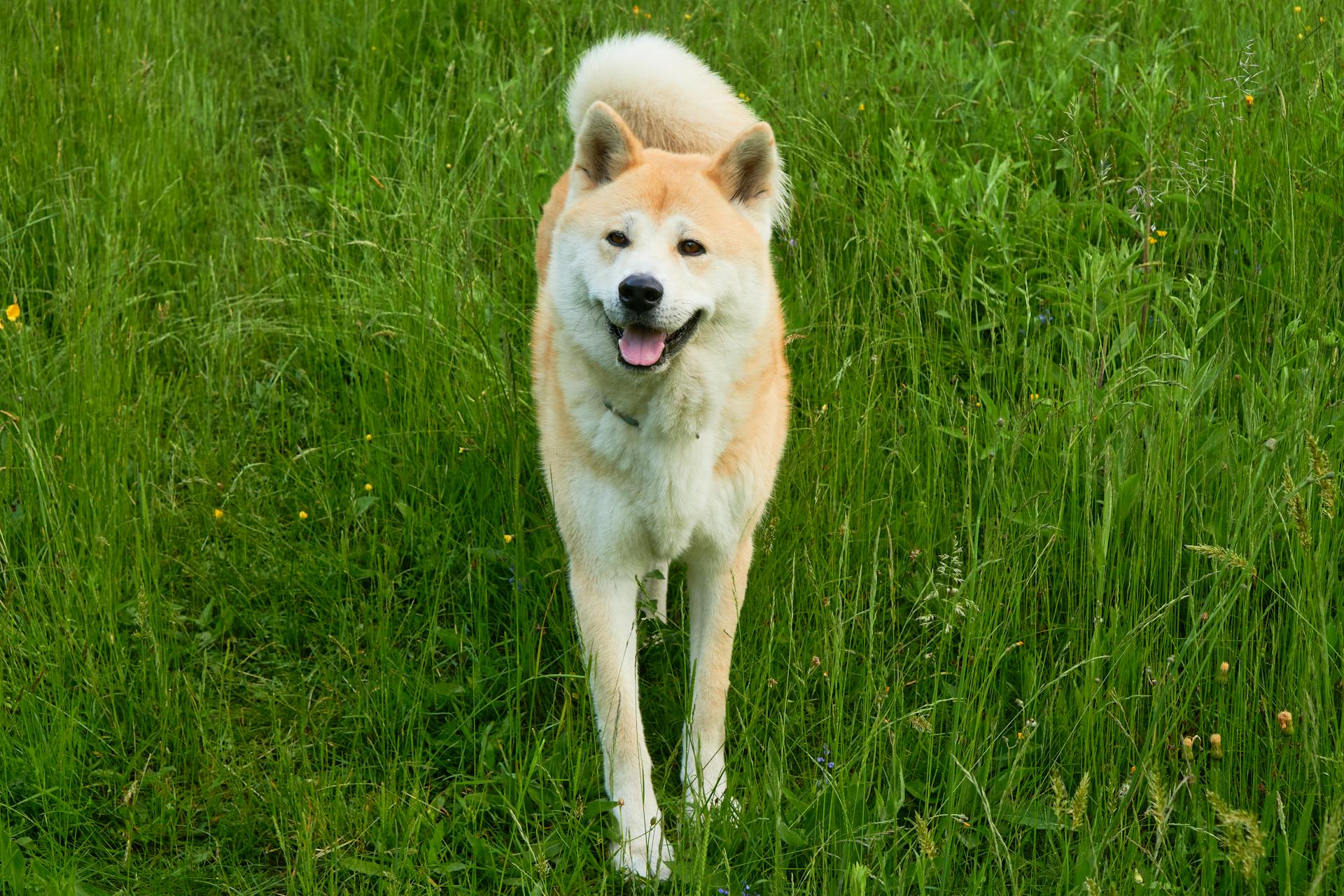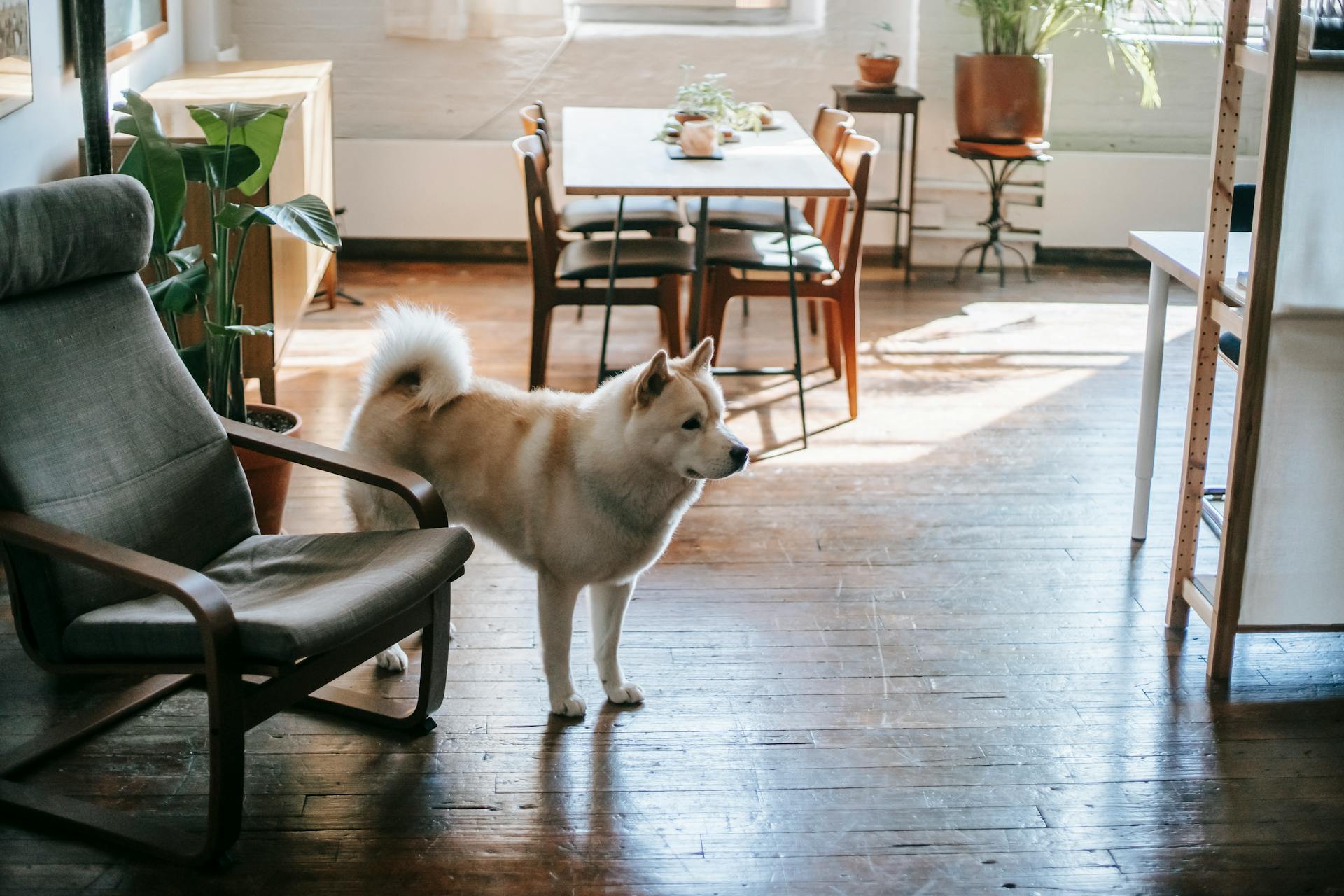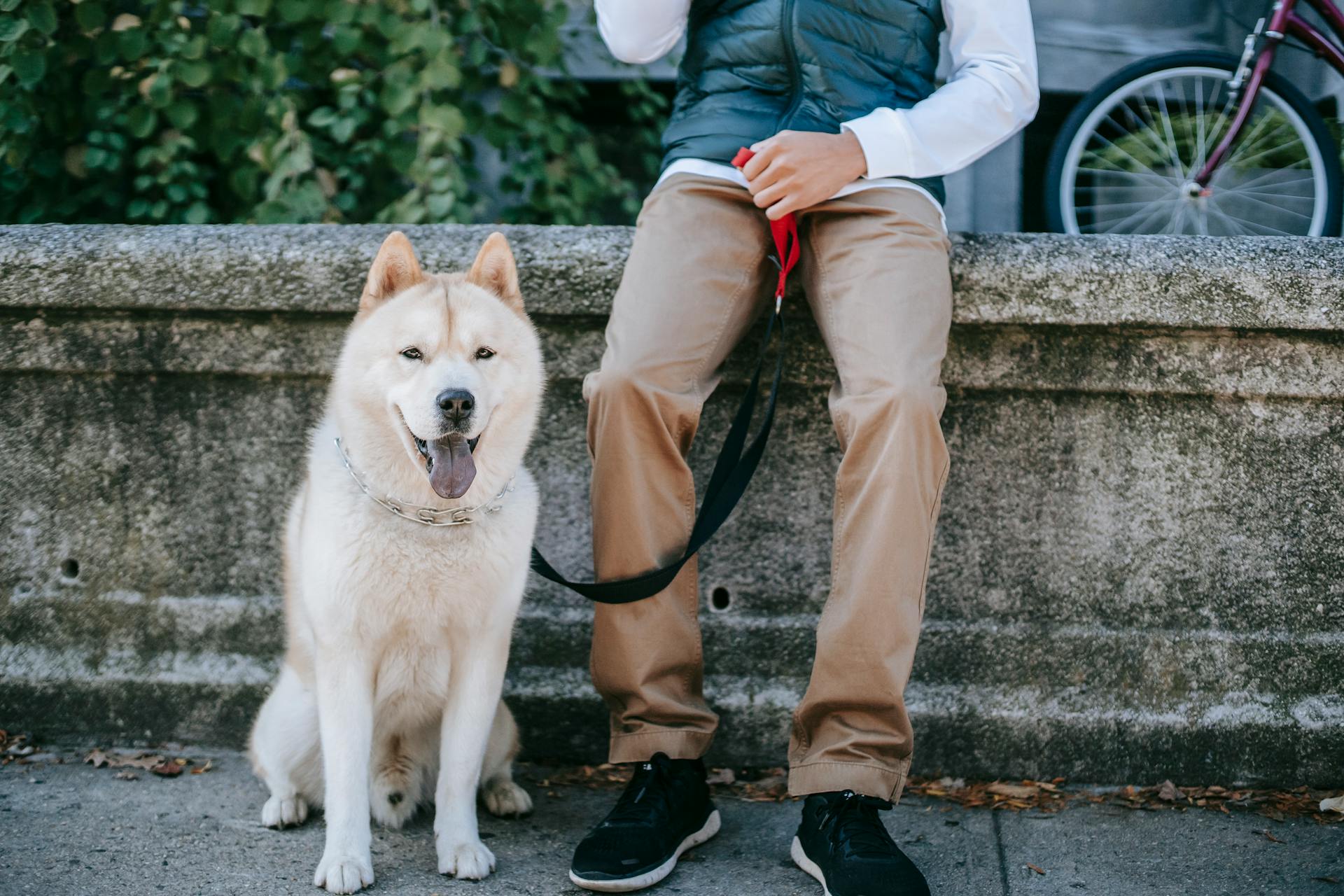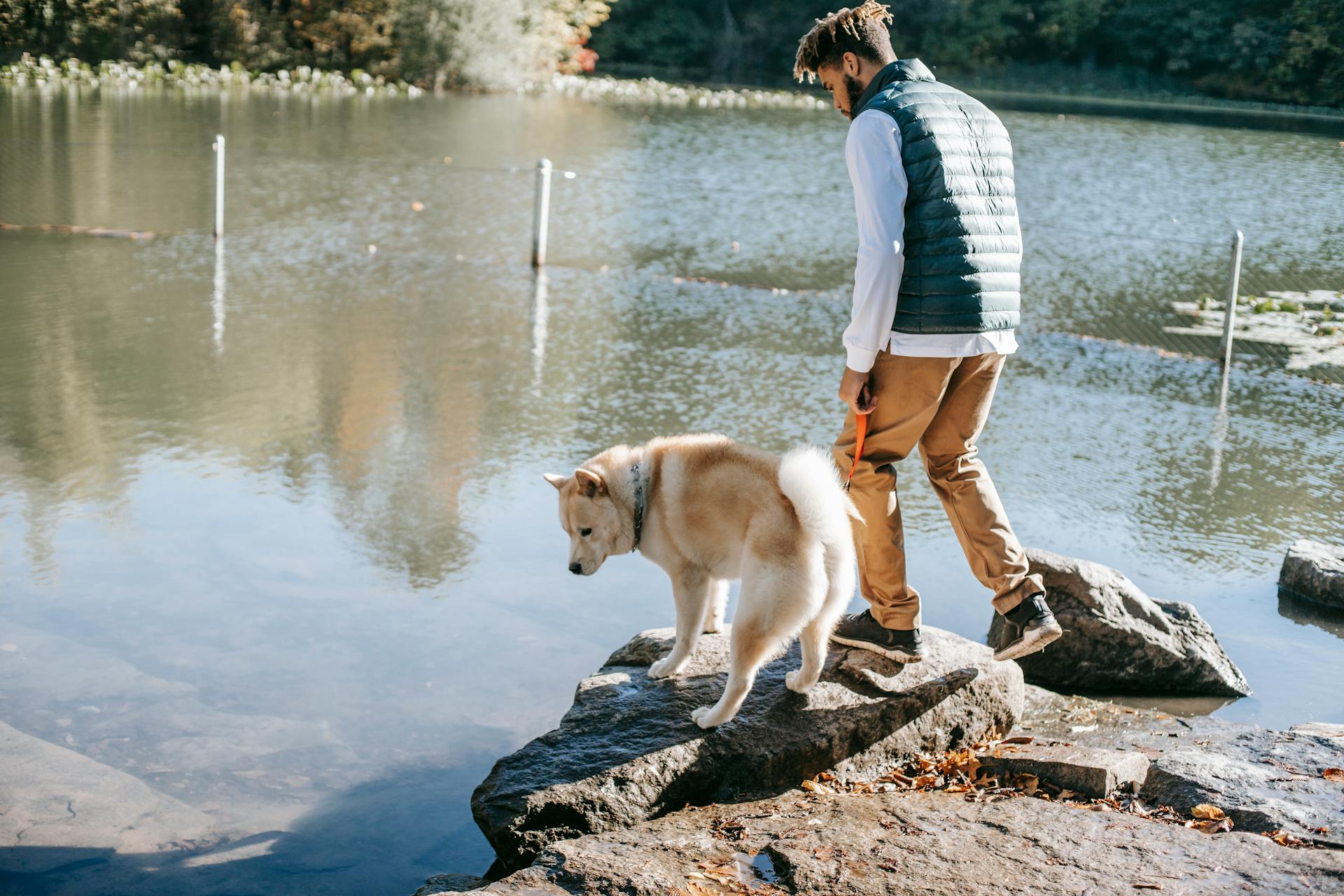
Akitas typically stop growing between 1-2 years of age, with most reaching their full height by 18-24 months.
At this stage, they'll have reached about 70-80% of their adult weight, which is a good indicator that they're nearing maturity.
Their growth rate will slow down significantly, and their adult weight will be reached within the next year or so.
Akitas usually reach their full adult weight between 2-3 years of age, which is a crucial milestone in their development.
Consider reading: When Do Siberian Huskies Stop Growing
Physical Development
Akitas go through various stages of physical development as they grow from birth to maturity. Understanding these stages is essential for ensuring the proper care and well-being of your Akita.
Between eight weeks and six months of age, Akitas undergo rapid growth and development, with their bodies growing in size and bones becoming stronger. Their exercise requirements may increase during this period, and it's essential to provide them with regular physical activity to support their muscle and bone development.
By the time Akitas reach six months, they enter the adolescent stage of development, and their bodies start to mature. They will gradually build muscle mass and become more proportional, but it's crucial to maintain a balanced diet and provide regular exercise during this stage.
Akitas typically reach full size between one and two years of age, with males weighing between 85-130 lbs and females weighing 65-110 lbs.
Infancy (0-8 weeks)
During the first eight weeks of an Akita's life, they experience significant growth and development.
At this stage, they are entirely reliant on their mother's milk for nutrition.
It's essential to provide a warm and secure environment for the puppies to thrive.
They receive crucial antibodies from their mother's milk that help protect them from diseases.
Proper veterinary care is vital during this period to ensure the puppies stay healthy.
See what others are reading: When Do Puppies Grow Out of Zoomies
Six Months to 1 Year
At six months old, your Akita enters the adolescent stage of development, where they experience growth spurts and their bodies start to mature.

During this period, their exercise requirements may increase, and it's essential to provide them with regular physical activity to support their muscle and bone development.
As Akitas grow, they need more food to support their rapid development, so be sure to provide a high-quality diet specifically formulated for puppies.
By six months, your Akita's body is getting stronger, but they still need plenty of rest and relaxation to help their bones and muscles grow.
It's essential to maintain a balance between exercise and rest to ensure your Akita develops at a healthy pace.
Factors Affecting Growth
Akitas are known to be a large breed, and their growth is influenced by several factors.
Their skeletal growth determines how tall they will become as adults, which can take anywhere from 6 to 24 months.
Multiple factors play a role in their growth and development.
Their bones grow from two distinct places called growth plates, which are somewhat flexible and soft during puppyhood.
The growth plates harden into bone as the puppy grows, and when they stop producing new tissue and become completely calcified, they are said to have 'closed', meaning they've stopped growing and the bone has reached its final size.
Even after the bones are fully developed, your puppy will continue to develop fat and muscle, just as human adults do.
The size of your Akita can be affected by its parents, with larger parents often resulting in a larger puppy.
The dog's sex also plays a role in its size, with males being much larger than females.
What your Akita eats can also impact its size, with a high-protein and calorie diet likely resulting in a larger and heavier dog.
Exercise can also affect how muscular and big your Akita will grow to be, with regular exercise leading to a leaner and more muscular dog.
Worth a look: Akita Puppy American
Monitoring Growth
Monitoring your Akita's growth is crucial for their overall development. Regularly measure their height and weight to ensure they're on track.
Akitas typically reach their full height between 6 to 24 months, with their skeletal growth determining how tall they'll become as adults. Keep an eye on their physical appearance to ensure they're developing as expected.
Consult with your veterinarian if you have any concerns or questions about your Akita's growth. They can provide valuable insights and help you make adjustments to their care as needed.
Monitoring your Akita's growth involves observing their height at different stages, comparing it with a growth chart, and ensuring they maintain a healthy weight. A well-balanced diet and regular exercise are essential for their growth and overall size.
Akitas are sturdy, muscular dogs, and their growth usually slows down at around 10 months but can continue until they're two years old. Males typically weigh between 100-130 pounds, while females weigh 70-100 pounds.
Regularly measuring your Akita's height and weight will help you identify any potential issues early on, allowing you to make adjustments to their care and ensure they reach their full potential in size and health.
Related reading: How Big Are Akitas
Signs of Stopping Growth

Signs of stopping growth in Akitas are an important milestone to recognize. As they reach their full size, their growth rate slows down and eventually stops.
Puppies continue to grow in height and size until their bones are fully developed, which can take anywhere from 6 to 24 months. This is determined by the growth plates in their legs, which produce new tissue that eventually hardens into bone.
One of the signs that an Akita has stopped growing is a plateau in height. If their height has remained consistent for several months with no noticeable increase, it's likely that their growth in height has stopped.
A plateau in weight is another indicator that your Akita has reached its full size. Once their weight stabilizes and there are no significant increases, it suggests that their growth in terms of weight has ceased.
As your Akita grows, their skeletal growth is what determines how tall they will become as adults. The growth plates in their legs are flexible and soft during puppyhood, but eventually harden into bone as they develop.
Physical Characteristics

Akitas are large, powerful dogs with a striking appearance. They have a commanding presence that makes them stand out in a crowd.
Male Akitas typically weigh between 85-130 lbs, while females weigh 65-110 lbs. In terms of height, males stand at around 27 inches at the withers, and females at about 25 inches.
Their thick double coat serves as insulation and protection against harsh weather conditions. This double coat consists of a soft, dense undercoat and a slightly longer, coarse outer coat.
Akitas come in various coat colors, including red, white, and brindle. Their coats require regular maintenance, such as frequent brushing, to minimize shedding and keep the coat healthy.
Genetics
Genetics play a significant role in determining the size and growth rate of Akitas. The genetics of the parents affect the potential size and physical characteristics of the puppies.
Responsible breeders prioritize the health and well-being of their breeding dogs, which is crucial when choosing a breeder.
Genetics influence the size and growth rate of Akitas, making every puppy unique.
Physical Appearance
A fully grown Akita has a well-defined musculature and proper proportions, giving them a balanced and mature appearance overall.
Their commanding presence makes them stand out in a crowd, thanks to their striking appearance and large size.
Male Akitas typically weigh between 85-130 lbs, while females weigh 65-110 lbs.
Females stand at about 25 inches at the withers, while males stand at around 27 inches.
Their thick double coat consists of a soft, dense undercoat and a slightly longer, coarse outer coat, serving as insulation and protection against harsh weather conditions.
Regular maintenance is essential, including frequent brushing to minimize shedding and keep the coat healthy.
Heavy shedding occurs during warmer months as Akitas shed their undercoat, allowing them to stay cool during hot weather.
Their erect triangular ears and expressive eyes give them an intelligent and alert appearance.
Their full, upright curled tail adds to their distinctive look, further enhancing their appeal as a unique breed.
Monitoring your Akita's diet and exercise is crucial in ensuring their well-being, especially considering their large size and potential health risks.
Broaden your view: Akita Dog Shedding
Average Weight

Akitas are large dogs, and their weight can vary between males and females. Males typically weigh between 85-130 lbs.
Their weight can be a good indicator of their growth and overall health. Females, on the other hand, weigh between 65-110 lbs.
A plateau in weight is another indicator that your Akita has reached its full size. This means that their weight stabilizes and there are no significant increases.
Their weight can be affected by their diet and exercise, so it's essential to monitor these factors to ensure their well-being.
Behavioral Changes with Age
As Akitas grow and mature, they undergo significant behavioral changes that are influenced by their age and development.
Puppies are naturally curious and playful, but as they reach adolescence, they may become more independent and stubborn. This is a normal part of their growth and development.
Akitas typically reach physical maturity between 1-2 years of age, but their behavioral maturity can take longer to develop. With patience and consistent training, you can help your Akita reach its full potential.
At around 2-3 years of age, Akitas often enter a period of stability and calmness, where they become more confident and less energetic. This is a great time to reinforce good behavior and continue training.
As Akitas age, they may also become more protective of their family and territory, which can manifest in a stronger sense of loyalty and attachment. This is a natural part of their evolution as a breed.
Growth Timelines
Akitas take a bit of time to reach their full size, but don't worry, we've got a rough idea of what to expect. Generally, they reach physical maturity between two and three years of age, with their growth plates closing and their bodies reaching their adult size and weight.
Between 6 to 24 months, puppies continue to grow in height and size, with their skeletal growth determining their final height. It's a gradual process, but by 18 months, most Akitas have reached about 100% of their adult size.
Giant breed puppies, like Akitas, take a bit longer to grow, with some reaching full size at 24 months of age. It's essential to remember that individual growth rates can vary, and some Akitas may continue to fill out and gain muscle mass beyond this timeframe.
Here's a rough estimate of an Akita's growth timeline:
Keep in mind that these are just rough estimates, and individual Akitas may grow at their own pace.
Sources
Featured Images: pexels.com

